- Right ascension (α, R. A. – derived from the English term “right ascension”) represents the length of the arc on the celestial equator from the vernal equinox to the declination circle of the celestial body. Right ascension serves as one of the dimensions in the second equatorial system (the first one being the hour angle). The second dimension is the declination.
Direct Ascension is measured in the eastward direction from the vernal equinox (opposite to the daily rotation of the celestial sphere). Direct ascension can be measured either in degrees (0° to 360°) or in hours (0h to 24h). In this case, 24h is equivalent to 360°.
Related concepts
Declination (δ) in astronomy – one of the two coordinates of the equatorial coordinate system. It represents the angular distance on the celestial sphere from the plane of the celestial equator to the luminary and is typically measured in degrees, minutes, and seconds of arc. Declination is positive when north of the celestial equator and negative when south of it.
The celestial equator is the great circle on the celestial sphere that is perpendicular to the axis of the Earth and coincides with the plane of the Earth’s equator. It divides the celestial sphere into two hemispheres: the northern hemisphere, which has its apex at the North Pole, and the southern hemisphere, which has its apex at the South Pole. The constellations that the celestial equator passes through are known as equatorial constellations.
The concept of epoch in astronomy (derived from the Greek word έποχή meaning “stop”) refers to a specific point in time that is used as a reference for determining astronomical coordinates or orbital elements. By recalculating astronomical coordinates from one epoch to another, taking into consideration precession and the object’s own motion, astronomers are able to accurately track the positions of celestial bodies.
The celestial sphere, an imaginary sphere with an arbitrary radius, is a useful tool in solving various astrometric problems. It serves as a projection surface for celestial bodies and is centered around the observer’s eye, which can be located on the Earth’s surface or in other points of space. For a terrestrial observer, the rotation of the celestial sphere mimics the daily motion of the stars and other celestial objects in the sky.
The galactic coordinate system is a celestial coordinate system that has its origin at the Sun and uses the center of the Milky Way galaxy as the reference direction. The plane of the galactic coordinate system aligns with the plane of the galactic disk. Similar to geographic coordinates, galactic coordinates consist of latitude and longitude.
References in literature
Asteroid Observation. The most convenient period for observing a regular minor planet, which orbits between Mars and Jupiter, is when it is closest to its opposition with the Sun. This occurs when the planet and the Sun are 180° apart in geocentric longitude. Around the time of opposition, the minor planet is at its minimum distance from Earth for the year, resulting in maximum brightness. The phase angle, which is the angle between the planet, the Sun, and Earth, is also close to its minimum, and the planet reaches its highest point in the sky around midnight. As the planet moves further away from opposition, the conditions for observation gradually worsen until it becomes impossible to continue observing. The average interval between oppositions for a minor planet depends on its average motion and the eccentricity of its orbit, typically ranging from 14-17 months. Nowadays, the term “opposition” is commonly used to refer to the point of direct ascent for minor planets in equatorial coordinates, but this does not significantly impact the information stated above.
The celestial equator serves as the foundation for the equatorial coordinate system, a system also utilized by astrologers. In this system, the position of a celestial body is determined by its declination (δ) and direct ascension (ά) coordinates.
To simplify the description of constellation boundaries, it was decided to represent them as discontinuous lines that align precisely with the grid of constant celestial coordinates – declination and direct ascension. As a result, constellations began to resemble certain African countries and American states, with borders following parallels and meridians. This approach proved to be a practical means of defining boundaries in a mathematical manner. However, over time, a minor flaw emerged in this clever concept.
Further related concepts
The astronomical unit (abbreviated as a.e. in Russian and au since 2012) is a unit of measurement historically used in astronomy. Originally, it was defined as the major semi-axis of the Earth’s orbit, which is considered to be the average distance from the Earth to the Sun: 126.
The Pole of the World is a celestial point where the visible daily movement of stars occurs as a result of the Earth’s rotation around its axis. The North Pole of the world aligns with the geographic north, while the South Pole of the world aligns with the geographic south. In the constellation of the Little Bear, you can find the North Pole of the world, which is marked by Polaris, also known as polarissima. On the other hand, the South Pole of the world is located in the constellation Octanthus. Due to the precession of the Earth’s axis, the poles of the world shift approximately 20 arcseconds per year.
The angular dimension, also known as the angle of view, refers to the angle formed by the straight lines connecting the observer’s eye to the diametrically opposite extreme points of the measured or observed object.
Ecliptica (derived from the Latin term (linea) ecliptica, which comes from the Greek word ἔκλειψις – eclipse) is a vast circle on the celestial sphere that marks the path of the Sun’s annual motion. Similarly, the ecliptic plane represents the plane of the Earth’s orbit around the Sun. In a more precise sense, the ecliptic is defined as the intersection of the celestial sphere and the plane of the barycenter orbit of the Earth-Moon system.
The galactic plane is the plane where the majority of a disk galaxy’s mass is concentrated. The perpendicular directions to the galactic plane indicate the poles of the galaxy. The terms “galactic plane” and “galaxy poles” are commonly used to describe the plane and poles of our own Milky Way galaxy.
In the realm of astronomical navigation, there are fifty-eight particular stars that hold a special significance. Out of the roughly 6000 stars that can be seen with the naked eye in ideal conditions, these chosen stars are some of the brightest and span across 38 constellations on the celestial sphere, ranging from a declination of -70° to +89°. Many of these navigational stars were given names in ancient times by the Babylonians, Greeks, Romans, and Arabs.
Octans (also known as Octanthus in Latin) is a small and extremely faint constellation located in the southern hemisphere of the sky, encompassing the South Pole of the Earth.
The astronomy field utilizes the celestial coordinate system to define the locations of celestial bodies in the sky and points on an imaginary celestial sphere. This system relies on two angular measurements, also known as arcs, to precisely determine the position of objects on the celestial sphere. Consequently, the celestial coordinate system is classified as a spherical coordinate system, where the third coordinate, distance, is frequently unknown and insignificant.
Stellar magnitude, also known as luster, is a non-dimensional quantitative measure of an object’s brightness. It is represented by the letter m, derived from the Latin word “magnitudo” meaning magnitude or size. This concept is primarily used in relation to celestial bodies. Stellar magnitude describes the energy flux emitted by the celestial object (i.e., the amount of energy released by all the photons per second) per unit area. As a result, the apparent stellar magnitude is influenced by both the intrinsic properties of the object itself (such as its luminosity) and the distance between the object and the observer. A lower stellar magnitude value indicates a dimmer object.
The period of sideric circulation (derived from the Latin word sidus, meaning star; in the genitive case sideris) denotes the duration in which a celestial satellite completes one full orbit around its primary body with respect to the stars. This notion of the “sideric period of revolution” is utilized to describe the motion of objects revolving around the Earth, such as the Moon (sideric month) and man-made satellites, as well as planets, comets, and other celestial bodies in orbit around the Sun.
Cassiopeia (Latin: Cassiopeia) is a constellation located in the Northern Hemisphere of the night sky. The brightest stars within Cassiopeia, with magnitudes ranging from 2.2 to 3.4, form a distinct pattern resembling the letters “M” or “W”. Spanning an area of 598.4 square degrees, this constellation contains approximately 90 stars that are visible to the naked eye and have a magnitude brighter than 6m. Cassiopeia is primarily situated within the Milky Way and is home to numerous scattered star clusters.
Absolute magnitude is a fundamental measure of an astronomical object’s luminosity. The specific definition of absolute magnitude varies for different types of celestial objects.
The catalog includes the most brilliant stars visible from our planet in the optical range, as measured by their apparent stellar magnitude. In cases where there are multiple stars, the cumulative stellar magnitude is provided.
A radiant (from Latin “radians” and “radiantis” meaning “radiating”) is a specific region of the celestial sphere that appears to be the origin point of meteors. These meteors become visible to us when Earth intersects with a group of meteoric bodies that are orbiting the Sun in a shared path.
Gemini, also known as Ara in Latin, is a constellation located in the southern hemisphere of the sky. It covers an area of 237.0 square degrees and contains 60 stars that can be seen with the naked eye. In the southern regions of Russia, specifically south of latitude 44° 30′, a small section of the constellation can be observed very close to the horizon during the months of May and June. It is important to note that no bright stars are visible in this area. However, the star α Sacristan, which has a magnitude of 2.95, is not visible in Russia. Nevertheless, under favorable conditions, it can be seen near the horizon line in southern cities located south of latitude 40° 08′, such as Bukhara, Samarkand, and Nakhichevan.
Naugol (also known as Norma in Latin) is a constellation located in the southern hemisphere of the sky. It can be found to the southwest of Scorpius and to the north of the Southern Triangle, with Circulus in close proximity. This region of the sky is traversed by both branches of the Milky Way, although it lacks prominent bright stars. Within the constellation, there are no stars that shine brighter than a visual sidereal magnitude of 4.0. A total of 42 stars can be observed with the naked eye, and the sky area covered by Naugol spans 165.3 square degrees. The optimal conditions for observing this constellation are in May and June, and it can be partially seen in southern Russia below a latitude of 48°N.
Pheonix (also known as Phoenix in Latin, abbreviated as Phe) is another constellation located in the southern hemisphere of the sky. It encompasses an area of 469.3 square degrees and contains 68 stars that can be seen without the aid of a telescope.
The progression of the equinoxes, also known as praecessio aequinoctiorum in Latin, refers to the gradual movement of the vernal and autumnal equinoxes. These equinoxes mark the points where the celestial equator intersects with the ecliptic and are shifting in alignment with the Sun’s yearly motion. To be more specific, each year the vernal equinox takes place slightly earlier than the previous year, with a difference of approximately 20 minutes and 24 seconds. In terms of angular units, this means there is currently an offset of about 50.3″ per year, equivalent to a 1-degree shift every 71.6 years. This is the extent of the offset.
Earth mass, denoted as M⊕ in astronomy (where ⊕ represents the Earth symbol), refers to the mass of our planet. It is commonly used as a unit of mass in the field of astronomy, independent of other systems. To be precise, 1 M⊕ is equal to (5.9722 ± 0.0006) × 1024 kg.
Variable stars are given special designations if they have not already been assigned a Greek letter in the Bayer designation format, combined with the name of the constellation in the genitive case where the star is located. (See List of constellations and their Latin names in the genitive case).
The constellation Monoceros (Latin for “unicorn”) is located along the celestial equator. It covers an area of 481.6 square degrees in the night sky and contains 146 stars that can be seen with the naked eye. Although it lies within the Milky Way, it does not have any bright stars. Monoceros can be easily found within the winter triangle formed by the bright stars Sirius, Procyon, and Betelgeuse. It is one of the 15 constellations that the celestial equator passes through and is visible in the central and southern regions.
This is a list of the nearest stars to Earth, arranged in order of increasing distance. It includes stars that are within 5 parsecs (16.308 light years) of our planet. As of now, there are 57 stellar systems known to be within this range, including our own Sun. These systems consist of a total of 64 stars and 13 brown dwarfs.
Cepheus, also known as Cepheus in Latin, is a constellation found in the Northern Hemisphere. Its shape resembles an irregular pentagon, and the southern part of the constellation lies within the Milky Way. It covers an area of 587.8 square degrees in the sky and contains 148 stars that can be seen without the aid of a telescope.
An occultation is a fascinating astronomical event where one celestial body passes in front of another, causing a portion of the latter to be obscured from the perspective of an observer at a specific location.
Passage, also known as celestial transit, is an astronomical event where one celestial body passes in front of another celestial body, blocking a portion of it, as seen from a specific vantage point.
Sails (or Vela in Latin) is a constellation located in the southern hemisphere of the sky. It borders the most densely populated regions of the Milky Way. It covers an area of 499.6 square degrees and contains 195 stars that can be seen without the aid of a telescope.
Reticulum (or Ret in Latin) is a constellation located in the southern hemisphere of the sky. It covers an area of 113.9 square degrees and contains 22 stars that can be seen without the aid of a telescope.
The major semi-axis is one of the primary geometric parameters that describes objects formed by conic sections.
Tucan (Latin. Tucana, Tuc) is a group of stars that form a constellation in the southern hemisphere of the sky. It covers a region of 294.6 square degrees in the sky and consists of 44 stars that can be seen without the aid of a telescope.
Eagle (Latin: Aquila) is a constellation located near the celestial equator. Its western portion is situated in the eastern part of the Milky Way, to the south of the constellation Arrow. This constellation spans an area of 652.5 square degrees, and there are a total of 70 stars with a magnitude brighter than 6m.
Redshift refers to the displacement of spectral lines towards the longer-wavelength (red) side. This occurrence can be attributed to weak diffuse scattering, the Doppler effect, gravitational redshift, or a combination of these factors. Conversely, the shift of spectral lines towards the shorter-wavelength (violet) side is known as blue shift. Hippolyte Fizeau, a French physicist, was the first to describe this phenomenon in 1848 and proposed that the Doppler effect caused by radiation could explain this shift.
An astronomical catalog, also known as a catalog of the starry sky, is a comprehensive list of astronomical objects such as stars, nebulae, and galaxies. These objects are typically classified based on their type, morphology, origin, means of detection, method of discovery, or other distinguishing features.
The Dorado constellation, also known as the Goldfish, is found in the southern hemisphere of the sky. It covers an area of 179.2 square degrees and contains 32 stars that are visible to the naked eye.
Pictor is a small constellation located in the southern hemisphere. It covers an area of 247.7 square degrees and has 49 stars that can be seen without the use of a telescope. In certain parts of southern Russia, a small section of the constellation can be seen, although it lacks bright stars. The first relatively bright star in the constellation is β Zhivopisets, which has a magnitude of 3.85 and rises south of latitude +38°56' in places like Dushanbe, Astara, Ashgabat, and Kushka. This star is situated within the Zhivopisitsa constellation.
Sculptor (Latin: Sculptor, Scl) is a constellation located in the southern hemisphere of the celestial sphere. It covers an area of 474.8 square degrees and encompasses 55 stars that can be observed without the aid of a telescope. Within the boundaries of the Sculptor constellation lies the South Pole of the Galaxy.
In the field of astronomy, the color index refers to the disparity in the magnitude of a celestial object when observed across two different spectral ranges.
Solar-type stars, solar analog stars, and solar doubles are three classifications of stars that bear resemblance to the Sun to varying degrees. The examination of these stars is of great significance in gaining a deeper comprehension of the Sun’s characteristics, its distinctiveness or, conversely, its similarity to other stars, as well as the potential existence of habitable planets in other solar-type stars.
Circulus (Latin: Circinus) is a small, faint constellation located in the western region of the sky, to the west of Naugol and Southern Triangle, and near the prominent star α Centauri. It was originally identified and named by the French astronomer Nicolas Louis de Lacaille in the year 1756. Unfortunately, this constellation is not visible from Russia. The most prominent star in Circulus is α Circulus, which is a binary system with a visual magnitude of 3.2. In the 20th century, two additional stars were discovered within this constellation, along with the remnants of a supernova known as SN 185, which was observed by Chinese astronomers during its eruption.
Microscope (Latin: Microscopium) is a small constellation located in the southern hemisphere of the sky. It is positioned to the south of Capricorn, to the north of Indian, to the east of Sagittarius, and to the west of South Fish and Crane.
The constellation known as Clock, or Horologium in Latin, is a vast and faint group of stars found in the southern part of the sky. It can be found to the southeast of the constellation Eridanus in the southern hemisphere. Clock spans an impressive 248.9 square degrees in the night sky and is home to 35 stars that can be seen without the aid of a telescope.
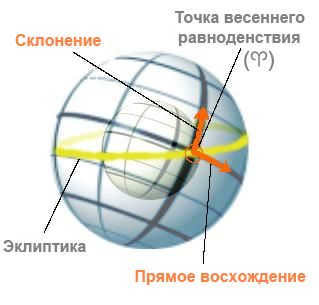
The direct ascension of (α, R. A. – from English. Right Ascension ) – the measurement of the angle along the celestial equator from the vernal equinox point to the circle of declination of the luminary. Right Ascension serves as one of the coordinates in the equatorial system. The second coordinate is declination.
Direct Ascension is calculated in the eastward direction from the vernal equinox point. It can be measured either in degrees (0° to 360°) or in hours (0 h to 24 h). In this case, 24 h is equivalent to 360°.
Direct ascension is the celestial equivalent of Earth’s longitude. Both direct ascension and longitude measure the east-west angle along the equator; both measures start from a zero point on the equator. The prime meridian serves as the origin of longitude on Earth, while the vernal equinox serves as the origin of direct ascension in the sky.
The significance of direct ascension is that if the sidereal time of an observer matches the direct ascension of a celestial body, it is at its highest point in the celestial sphere for that specific location of observation.
Origin
The notion of direct ascension was familiar during the era of Hipparchus, who established the position of stars in equatorial coordinates during the 2nd century B.C. However, Hipparchus and his successors compiled their star catalogs based on the ecliptic coordinate system.
With the advent of the telescope, it became feasible to observe celestial objects in more intricate detail. To ensure an extended period of time in the field of view, employing an equatorial mount that allowed the telescope to rotate around the polar axis proved to be convenient. Hence, the equatorial coordinate system was adopted.
The initial star catalog that employed direct ascension and declination to ascertain the coordinates of objects was the Historia Coelestis Britannica by John Flemsteed.
Sources
Wikimedia Foundation. 2010.
Discover the definition of “Direct Ascension” in other dictionaries:
- DIRECT ASCENT – Direct Ascension, in astronomy, is a coordinate used for determining the location of a celestial object. It is the angular distance measured eastward from the vernal equinox point (also known as the point of Aries) to the point where the spherical… … Scientific and Technical Encyclopedic Dictionary
- DIRECT ASCENT – (represented by ?) one of the equatorial coordinates; the arc of the celestial equator, measured from the vernal equinox point ? to the circle of declination of the luminary in the opposite direction of the celestial sphere’s diurnal rotation, ranging from 0 to 360 degrees… Large Encyclopedic Dictionary
- Direct Ascension – (α), one of the equatorial coordinates; it is the measurement of the arc of the celestial equator from the vernal equinox point h (in hourly measure). * * * * * * Direct Ascension is denoted by a (α), and it is one of the equatorial coordinates. It represents the arc of the celestial equator measured from the vernal equinox point h in hourly measure. … Encyclopedic Dictionary
- Direct Ascent – one of the coordinates in the equatorial system of celestial coordinates (See Celestial coordinates) … Bolshaya Sovetskaya Encyclopedia
- DIRECT ASCENT – See Celestial coordinates … Large Encyclopedic Polytechnic Dictionary
- DIRECT ASCENT – (referred to as a), is one of the equatorial coordinates. It represents the arc of the celestial equator that is measured from the vernal equinox point U to the luminary’s declination circle. This measurement is made in the direction opposite to the diurnal rotation of the celestial sphere, and it ranges from 0 to 360 degrees. This information can be found in the Natural History. Encyclopedic Dictionary.
- DIRECT ASCENT – The term “direct ascent” refers to the distance measured along the celestial equator, specifically eastward from the point of the vernal equinox. It can also be defined as the distance along the circle of declination. For more information, please see the Astrological Encyclopedia.
- RIGHT ASCENSION OF THE LUMINARIES – The right ascension refers to the angle along the celestial equator between the vernal equinox point and the meridian of the luminary. It is measured in degrees from 0 to 360, always starting from the vernal equinox point in the direction of the Sun’s own motion. P. V. S. are denoted … … Nautical Dictionary
- Direct ascension of the celestial luminary – One of the coordinates used in the equatorial system of celestial coordinates is the direct ascension. It is measured as an arc along the celestial equator from the vernal equinox to the luminary’s declination circle, but in the opposite direction to the daily rotation of the celestial sphere. The direct ascension … … Astronomical Dictionary
- Direct Ascension of the ascending node is an element in the orbit of a celestial body (See Orbits of Celestial Bodies). It is commonly utilized in the study of the motion of man-made satellites orbiting the Earth, where the equatorial plane serves as the primary plane and the reference point is … The Big Soviet Encyclopedia

At present, there are additional combined discounts (ranging from 2% to 25%) accessible to 58,742 educational establishments. To determine the applicable discount for all staff members of your educational institution, please sign in to your personal Infoworks account.


A course aimed at enhancing professional skills
Guidance for preschool teacher-psychologists: scope of work and ethical guidelines
In addition to this promotion, we also offer discounts for educational institutions based on the number of participants from your organization who have enrolled in Infoworks courses.
Currently, 58,742 educational institutions are eligible for additional discounts ranging from 2% to 25%. To find out the discount available for all employees of your institution, simply log in to your personal Infoworks account.


Professional retraining program
Teaching activity in the planning and implementation of the educational process in public educational establishments (course: “Physical Education and Fundamentals of Life Safety”).
In addition to this promotion, we can offer a discount based on the number of your colleagues who have enrolled in Infowork courses.
Currently, there are additional cumulative discounts (ranging from 2% to 25%) available for 58,742 educational institutions. To find out the discount applicable to all employees of your educational institution, please log in to your personal Infoworks account.


The Definition of Underachieving Children and Their Characteristics: An Analysis
An Overview of Education and Support for Underachieving Children

Slide 2: Astronomy is a discipline that has been around for centuries, making it one of the most ancient fields of study. Over time, the study of astronomy has revolutionized our understanding of the world beyond Earth, providing evidence that the universe is knowable and governed by universal laws that apply not only to our planet, but also to the far reaches of space.
By examining the composition and behavior of celestial bodies and the systems they form, astronomy delves into the intricate structure of the cosmos. Furthermore, it explores the fundamental properties of the universe that surrounds us.

Slide 4 – astronomical events,
– scientific institutions for researching astronomical events, contemporary observatories,
– celestial objects in the cosmos,
– entities within the solar system

Slide number 5 showcases the allegorical representation of the Muse Urania by Jan Hevelius, a renowned astronomer from Poland. It is interesting to note that astronomy is the sole scientific discipline that is associated with its own patron muse, Urania.



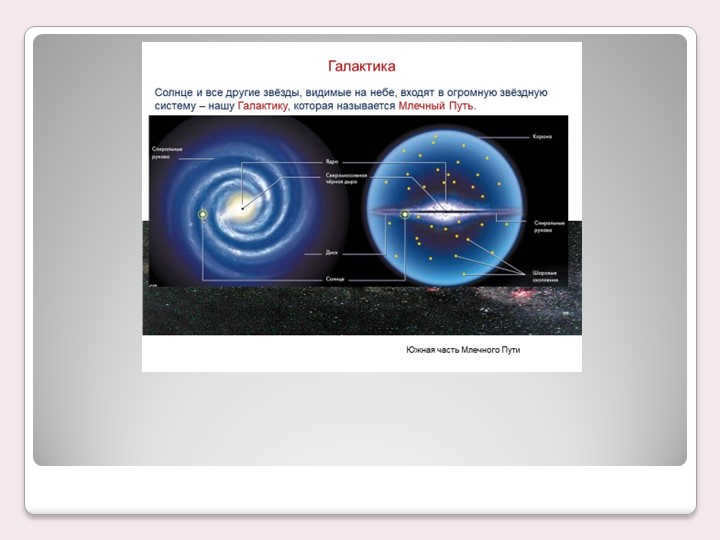


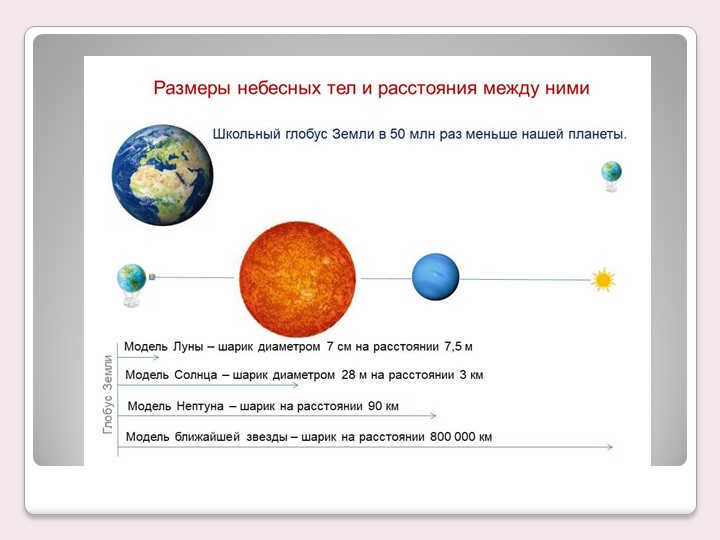

On the 14th slide, there is a lineup of various celestial objects. Starting from the top and going down, they are arranged in order of increasing size. The first object is a comet, followed by a planet, then a planetary system, a star, and finally a galaxy.



On slide 17, we have the magnificent Canary Telescope GTC and the impressive Very Large Telescope VLT. These state-of-the-art telescopes are equipped with advanced adaptive and active optics systems, allowing for unprecedented observations and discoveries.
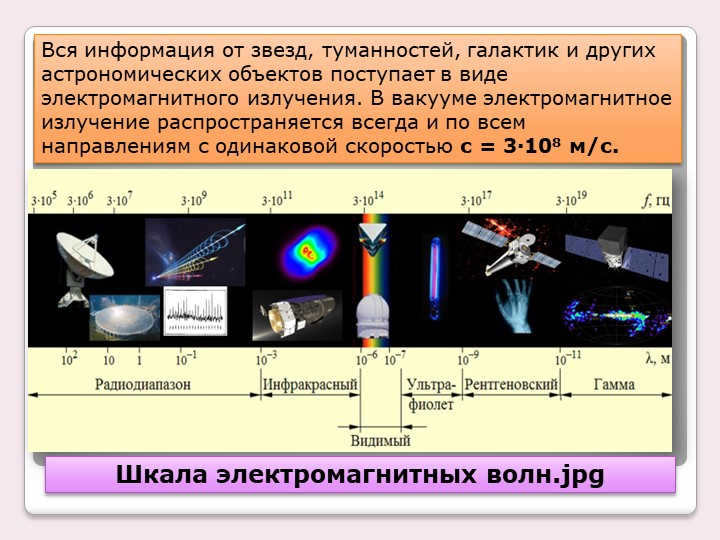
On the 18th slide, there is a diagram called Electromagnetic wave scale.jpg that illustrates the different types of electromagnetic radiation. This radiation carries all the information we receive from stars, nebulae, galaxies, and other celestial objects. It travels through space at a constant speed of c = 3-108 m/s in all directions, even in a vacuum.
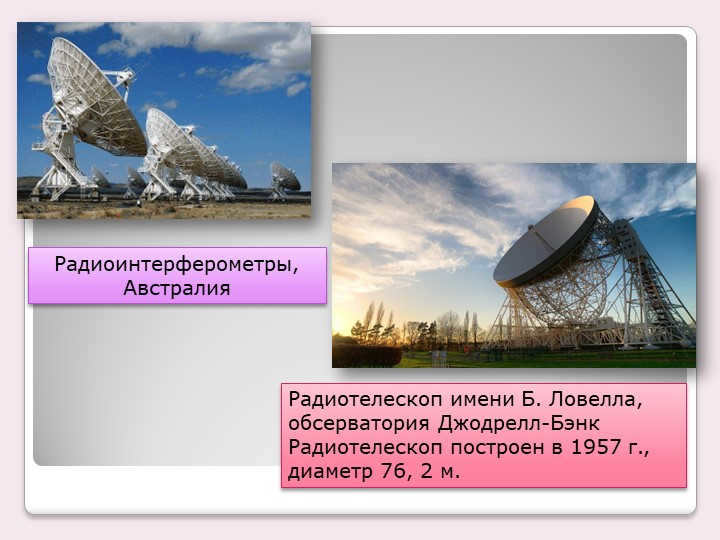
The B. Lovell Radio Telescope is one of the radio interferometers located in Australia at the Jodrell Bank Observatory. It was constructed in 1957 and has a diameter of 76.2 meters.
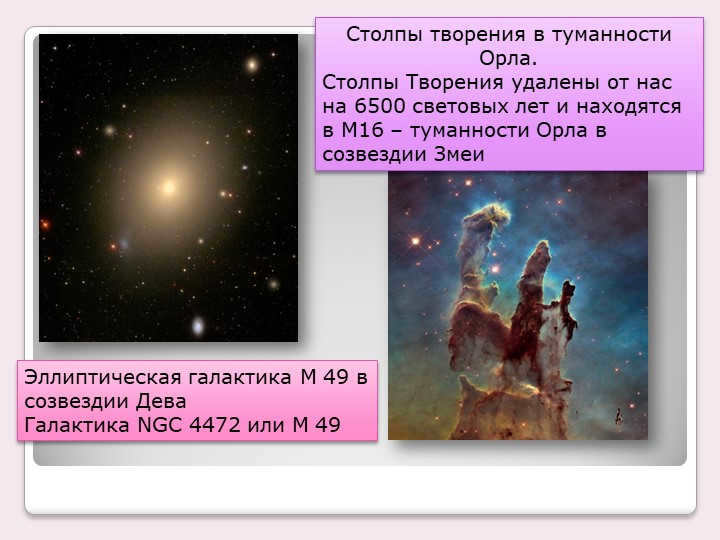

There are 20 slides that depict the Pillars of Creation in the Eagle Nebula.
The Pillars of Creation are positioned 6,500 light years away from us and can be found in M16, which is located in the Snake constellation.
In the constellation Virgo, you can find the elliptical galaxy M 49.
Another name for the galaxy NGC 4472 is M 49.

Slide 21: The Crab Nebula is what remains after a powerful explosion known as a supernova. The Hubble Space Telescope, located in the Centaurus A Galaxy and operated by the ESO Observatory in Chile, has captured stunning images of this celestial phenomenon.

Astronomy is the study of celestial objects and phenomena. It explores the universe beyond Earth and seeks to understand the nature of planets, stars, galaxies, and other cosmic entities. The field of astronomy encompasses various branches, including cosmology, cosmogony, and radio astronomy. Astrology, on the other hand, is not considered a division of astronomy.


Slide 23: Features of astronomy
-Observations serve as the primary source of information in the field of astronomy.
-Directly observing certain phenomena is not always possible due to their long durations, ranging from hundreds to millions and billions of years.
-Another unique aspect of astronomy is the need to indicate the spatial position (coordinates) of celestial bodies, while also facing the challenge of distinguishing their relative distances. Initially, all observed celestial objects appear equidistant from us.

The celestial equator is a circle that divides the sky into two equal halves. The angular distance of a luminary from the celestial equator is called declination, and it is represented by the letter δ. Similar to geographic latitude, declination is measured in degrees. Luminaries located north of the celestial equator have positive declination values, while those located south of it have negative values.
-The direct ascension is denoted by the letter α. It is measured along the celestial equator, starting from the point of the vernal equinox♈. In the field of astronomy, direct ascension is typically expressed in terms of hours.
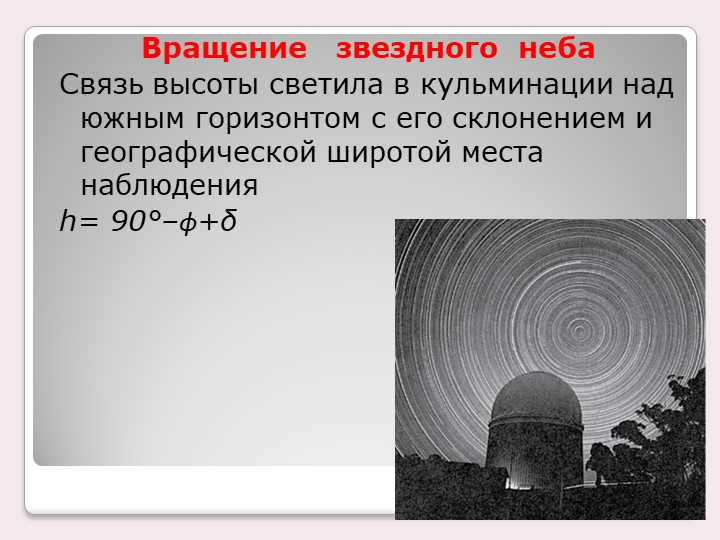
On Slide 26, we can observe the rotation of the starry sky. It is interesting to note the relationship between the height of the luminary at its highest point above the southern horizon and its declination, as well as the geographic latitude of the place where the observation is taking place. This relationship can be expressed by the equation h = 90° – ϕ + δ.


1. How many different starry sky coordinate systems have we talked about?
2. Which specific coordinate systems did we discuss?
1. We have talked about two different coordinate systems.
2. These coordinate systems are the horizontal coordinate system, which is related to the observer, and the equatorial coordinate system, which is related to the rotation of the celestial sphere.

1. What are the latitudes on Earth where the plane of the horizon aligns with the plane of the ecliptic?
2. Is there any location on Earth where the celestial sphere rotates around a plumb line?
3. Where on Earth will all the celestial bodies rise and set?
4. Which celestial bodies can have both an upper and lower culmination?
5. How many time zones can coexist on Earth simultaneously?

1.The direct ascent is marked by a latitude of 23.5°.
2.These locations represent the north and south poles.
3.The equator is another location where the direct ascent occurs.
4.The non-sunset is also a place where the direct ascent can be observed.
5.There are two specific dates associated with the direct ascent.
Brief document overview:
This is a presentation aimed at first-year students in specialized secondary institutions, providing an introduction to astronomy. It serves as the initial lecture in the astronomy curriculum, and can be supplemented with video clips. The presentation also includes assignments to reinforce the concepts covered.
In addition, there are worksheets and teaching materials available for educators.
We offer a collection of over 10,000 educational resources for both school and home learning.
Topics covered in the presentation include:
- The horizontal and equatorial celestial coordinate systems.
- The concept of direct ascension and the declination of celestial bodies.
- Guidance on conducting evening astronomical observations of the night sky.
- An overview of the celestial sphere, including its key points, lines, and circles.
Let’s take a look at the key features and circles of the celestial sphere, where the center O represents the observer’s eye (Fig. 72). We can trace a vertical line through the center of the celestial sphere, known as the plumb line. The points where the plumb line intersects with the sphere are referred to as the zenith Z and nadir p.
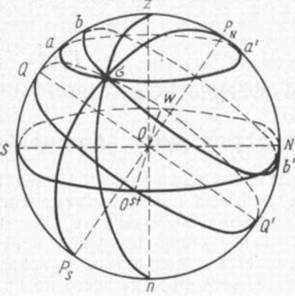
Figure 72.
The plane that passes through the center of the celestial sphere and is perpendicular to the plumb line is known as the plane of the true horizon. This plane intersects the celestial sphere and forms the circumference of a great circle, which is called the true horizon. The true horizon divides the celestial sphere into two parts: the supra-horizon and the sub-horizon.
The line that passes through the center of the celestial sphere and runs parallel to the earth’s axis is known as the world axis. The points where the world axis intersects with the celestial sphere are referred to as the poles of the world. One of these poles, in accordance with the Earth’s poles, is called the northern pole of the world and is labeled Pn, while the other is known as the southern pole of the world and is designated Ps.
The plane QQ’, which passes through the center of the celestial sphere and is perpendicular to the world axis, is known as the plane of the celestial equator. This plane intersects with the celestial sphere to form a large circle known as the celestial equator. It divides the celestial sphere into its northern and southern parts.
The celestial sphere’s great circle, which passes through the earth’s poles, zenith, and nadir, is known as the observer’s meridian PN nPsZ. The earth’s axis divides the observer’s meridian into two parts: the noon PN ZPs and midnight PN nPs.
The meridian of the observer intersects with the true horizon at two points: the north point N and the south point S. The line that connects the north and south points is called the noon line. It is also known as the noon line.
If one looks from the center of the sphere towards point N, the right side will be the east point O st, and the left side will be the west point W. The small circles on the celestial sphere, aa’, which are parallel to the plane of the true horizon, are referred to as almucantarates; the small circles bb’, which are parallel to the plane of the celestial equator, – are called celestial parallels.
Verticals are circles of the celestial sphere Zon that pass through the points of zenith and nadir. When the vertical passes through the points of east and west, it is called the first vertical.
The circles of declination, also known as the circles of the celestial sphere PNoPs, pass through the poles of the world.
The meridian of the observer is both a vertical and a circle of declination. It divides the celestial sphere into two parts: east and west.
The raised (lowered) pole of the world is the pole of the world located above (under) the horizon. The name of the raised pole of the world is always the same as the name of the latitude of a place.
The axis of the world, when intersecting with the plane of the true horizon, creates an angle that is equal to the geographical latitude of a place.
The idea of the celestial sphere originated in ancient times; it was based on the visual perception of a dome-shaped celestial vault. This perception arose because the celestial luminaries are so far away that the human eye cannot perceive the differences in their distances, making them appear equidistant. Ancient civilizations believed that there was a real sphere encompassing the entire world, adorned with countless stars. Thus, they considered the celestial sphere to be the most significant element of the universe. As scientific knowledge advanced, this concept of the celestial sphere was discarded. However, the ancient geometry of the celestial sphere, which was developed and refined over time, has evolved into its modern form and is still used in astrometry.
Components of the celestial sphere
Vertical line and associated ideas
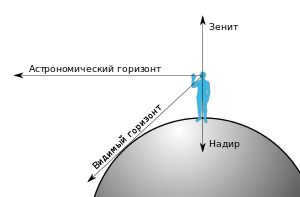

The diagram above showcases the connection between zenith, nadir, and horizon in various definitions. It is important to note that zenith is the opposite of nadir.
Plumb line refers to a straight line that passes through the center of the celestial sphere and an observation point on Earth’s surface. This line intersects the celestial sphere at two points – the zenith above the observer’s head and nadir beneath the observer’s feet.
The actual (mathematical) horizon refers to the great circle of the celestial sphere that is perpendicular to the plumb line. This horizon divides the celestial sphere’s surface into two hemispheres: the hemisphere that is visible with its highest point at the zenith, and the hemisphere that is invisible with its highest point at the nadir. It is important to note that the actual horizon does not align with the visible horizon due to the observer’s height above the Earth’s surface and the bending of light rays in the atmosphere.
The luminary forms a coordinate grid consisting of the circle of altitude, also known as the vertical luminary, and the almucantarate. The circle of altitude is a large semicircle that passes through the luminary, zenith, and nadir. On the other hand, the almucantarate is a small circle with a plane parallel to the mathematical horizon. Together, these circles determine the horizontal coordinates of the luminary.
The Earth’s axis – A hypothetical line that runs through the center of the Earth and around which the celestial sphere appears to rotate. The Earth’s axis intersects the celestial sphere at two points – the North Pole and the South Pole. The celestial sphere rotates counterclockwise around the North Pole when viewed from the inside.
The celestial equator – A large circle on the celestial sphere that is perpendicular to the Earth’s axis and passes through the center of the celestial sphere. The celestial equator divides the celestial sphere into two hemispheres: the Northern Hemisphere and the Southern Hemisphere.
Circle of declination of a luminary – a celestial sphere’s circle that passes through the poles of the globe and the specified luminary.
Daily parallel – a small circle on the celestial sphere whose plane is parallel to the plane of the celestial equator. The apparent daily movements of luminaries occur on these daily parallels. Declination circles and daily parallels create a coordinate grid on the celestial sphere, establishing the equatorial coordinates of the luminary.
Terms originating from the intersections of the concepts “Plumb Line” and “Rotation of the celestial sphere”
The celestial equator intersects with the mathematical horizon at the point of the east and the point of the west. The eastern point is where the objects on the rotating celestial sphere emerge from behind the horizon. The half-circle of altitude that passes through the eastern point is known as the first vertical.
Celestial meridian – the major circle of the celestial sphere whose plane intersects with the plumb line and the axis of the world. The celestial meridian divides the surface of the celestial sphere into two hemispheres: the eastern hemisphere and the western hemisphere.
Noon line – The line where the plane of the celestial meridian intersects with the plane of the mathematical horizon. The noon line and the celestial meridian intersect the mathematical horizon at two points: the northern point and the southern point. The northern point is the one that is closer to the North Pole of the world.
Yearly motion of the Sun on the celestial sphere and associated ideas

P, P’ – the extremes of the globe, T, T’ – the equinox points, E, C – the solstice points, P, P’ – the extremes of the ecliptic, PP’ – the axis of the world, PP’ – the axis of the ecliptic, ATQT’ – the celestial equator, ETCT’ – the ecliptic
Ecliptic – the major circle of the heavenly sphere, through which the visible yearly movement of the Sun happens. The plane of the ecliptic intersects with the plane of the celestial equator at an angle e = 23°26′.
The equinox points, where the ecliptic intersects the celestial equator, are known as the vernal equinox and the fall equinox. At the vernal equinox, the sun moves from the southern hemisphere to the northern hemisphere, while at the fall equinox, it moves from the northern hemisphere to the southern hemisphere. The solstice points, which are 90 degrees away from the equinoxes and farthest from the celestial equator, are designated as the summer solstice point in the northern hemisphere and the winter solstice point in the southern hemisphere. These four points are represented by zodiac symbols, corresponding to the constellations they were in during Hipparchus’ time (although the precession of the equinoxes has caused these points to shift into different constellations): Aries (♈) for the spring equinox, Libra (♎) for the autumn equinox, Capricorn (♑) for the winter solstice, and Cancer (♋) for the summer solstice.
Ecliptic Axis: The ecliptic axis is the perpendicular diameter of the celestial sphere that intersects with the surface at two points – the northern pole of the ecliptic in the northern hemisphere and the southern pole of the ecliptic in the southern hemisphere. The north pole of the ecliptic is located in the constellation Dragon with equatorial coordinates R.A. = 18h00m and Dec = +66°33′, while the south pole is found in the constellation Goldfish with R.A. = 6h00m and Dec = -66°33′.
Circle of Ecliptic Latitude: Also known as the circle of latitude, it is a large semicircle on the celestial sphere that passes through the poles of the ecliptic.
In the field of astronomy, the celestial coordinate system includes two terms: declination (in French, AD, or RA in English for right ascension) and right ascension. Right ascension is analogous to terrestrial longitude on the celestial sphere.
Just as longitude measures the distance east or west between a place’s meridian and a reference meridian (also known as the prime meridian) at the Earth’s equator, right ascension measures the angle between a star’s hour circle and the reference hour circle at the celestial equator. However, unlike Earth’s longitude, right ascension is always calculated in the ascending direction towards the east.
Just like how the intersection of the Greenwich meridian and the equator acts as a point of reference for measuring longitude on Earth, there is also a point of reference for measuring right ascension. This reference point, known as the spring point and denoted as g or γ, is one of the two points where the celestial equator and the ecliptic intersect. The hour circle passing through this point serves as the standard hour circle for measurements. The sun’s path through these two intersection points corresponds to the equinoxes. The vernal point, denoted as gamma, represents the sun’s position at the March equinox (the beginning of spring in the northern hemisphere and fall in the southern hemisphere).
Thus, determining the duration for a star to reach a specific point in the sky is made simple by direct ascension in sidereal time. For instance, if a star with direct ascension is on the meridian at 1:30:00 AM, it will take 18:30 AM for another direct ascension star at 20:00:00 AM to be on the meridian (20:00 AM – 1:30 AM).
Direct ascension is not the sole angle utilized in positioning stars. In Chinese astronomy, for instance, rouxiu was employed, where a set of 28 points distributed on the celestial equator served as the reference point rather than a spring point. The chosen reference point for a given measurement was determined by the region of the sky where the star (its lunar bed) was situated.
Measuring Units for Vertical Ascension
An hour of vertical ascension is a standard unit for measuring plane angles and is equivalent to 360° / 24 = 15°.
A minute of vertical ascension is a smaller division of the hour and is logically equal to 1/60th of an hour of vertical ascension, 1/4 degree, or 15 minutes of angle.
Similarly, a second of vertical ascension is equal to 1/60th of a minute of vertical ascension, 1/3600th of an hour of vertical ascension, 1/240th of a degree, 1/4 of an angular minute, or 15 angular seconds.
Furthermore, a third of vertical ascension corresponds to 1/60th of a second of vertical ascension, 1/216000th of an hour of vertical ascension, 1/14400th of a degree, 1/4 arc second, or 15 thirds of an arc. However, the usage of this last unit is not widespread.
Therefore, it is important not to mix up minutes or seconds of direct ascent with minutes or seconds of arc. Hours, minutes, and seconds of direct ascension are specifically used to calculate celestial longitude. On the other hand, degrees, minutes, and arc seconds are employed to measure any type of angle. In general, when discussing angles, the mention of seconds (or minutes) typically refers to arc seconds (or arc minutes) unless otherwise specified.
- Right ascension (α, R. A. – derived from the English term “right ascension”) represents the length of the arc on the celestial equator between the vernal equinox point and the luminary’s declination circle. Right ascension serves as one of the coordinates in the second equatorial system (the first equatorial system utilizes the hour angle as the primary coordinate). The second coordinate is known as declination.
The direct ascension is measured in the eastern direction from the vernal equinox point (i.e., in the opposite direction to the daily rotation of the celestial sphere). Direct ascension can be measured either in degrees (0° to 360°) or in hours (0h to 24h). In this case, 24h is equivalent to 360°.
Similar ideas
Declination (δ) in the field of astronomy is one of the two components of the equatorial coordinate system. It represents the angular separation on the celestial sphere from the plane of the celestial equator to a particular celestial object, and is typically measured in degrees, minutes, and seconds of arc. Declination is considered positive when located north of the celestial equator, and negative when situated south of it.
The celestial equator is a significant circle on the celestial sphere, its plane being perpendicular to the axis of the Earth and aligning with the plane of the Earth’s equator. This celestial equator separates the celestial sphere into two halves: the northern hemisphere, centered on the North Pole, and the southern hemisphere, centered on the South Pole. The constellations traversed by the celestial equator are known as equatorial constellations.
The galactic coordinate system is a celestial coordinate system that has its origin in the Sun and its reference direction from the center of the Milky Way galaxy. The galactic coordinate system’s plane aligns with the plane of the galactic disk. Similar to geographical coordinates, galactic coordinates consist of latitude and longitude.
References in the literary works
Hipparchus was the pioneer in describing different climates based on the stellar phenomena observed in them, setting a precedent for future astronomers. He divided the boundaries into increments of 70 miles, which he found to be a convenient distance for noticeable changes in the starry sky. Using his own catalog of 1,080 stars, Hipparchus created a comprehensive map of the starry sky, surpassing anything that had been compiled before. To further verify his findings, he calculated various measurements for each parallel, such as the theoretical length of the day on the summer solstice, the ratio of the gnomon’s length to the length of its shadow, the altitude of Polaris, and the direct ascension of certain bright stars. Among his notable observations, he discovered that Cinnamon Country, located south of the equator, is the furthest point where the Little Bear never sets. In Siena, most of the seven stars of the Big Dipper are visible year-round, while the region north of Byzantium and Cassiopeia falls entirely within the stellar Arctic circle. Despite the fascinating nature of this information, it remained purely theoretical in the field of astronomy at that time. There were still unexplored places on Earth, making it impossible to practically test the theoretical data and confirm its accuracy in relation to specific locations.
To make it easier to define the boundaries of the constellations, it was decided to represent them as broken lines aligned with the grid of celestial coordinates – declination and right ascension. As a result, the constellations started to resemble certain African countries and American states, whose borders are defined by parallels and meridians. This approach provides a rational method to clearly delineate the boundaries in mathematical terms. However, over time, a small drawback in this ingenious concept became evident.
According to numerous astronomy textbooks, it is well-known that in ancient times, the sky was divided into 24 distinct wing-shaped regions. These regions, also referred to as the STAR WATCH or the WATCH of Direct Ascension of the Stars, converge at the poles of the celestial sphere. This division of the sky into 24 sectors serves as the coordinate system for measuring celestial objects. A medieval illustration in Zacharias Bornman’s book, as shown in Figure 11, clearly demonstrates the use of these 24-hour sectors on a celestial globe.
Further related concepts
The concept of an Astronomical unit (abbreviated as a.u.; internationally known as au since 2012; previously designated as ua) has long been used as a unit of distance measurement in the field of astronomy. Originally, it was defined as the major semi-axis of the Earth’s orbit, which is commonly accepted as the average distance between the Earth and the Sun: 126.
The Celestial Pole is a point on the celestial sphere where the visible daily movement of stars occurs due to the Earth’s rotation around its axis. The North Celestial Pole aligns with the geographic north, while the South Celestial Pole aligns with the geographic south. The North Celestial Pole can be found in the constellation Ursa Minor, specifically at Polaris, and the South Celestial Pole is located in the constellation Octans. Due to the Earth’s axis precession, the celestial poles shift by approximately 20 arcseconds per year.
Angular measurement, also known as the angle of view, refers to the angle between the straight lines connecting the diametrically opposite extreme points of the observed object and the observer’s eye.
Ecliptica (derived from the Latin term (linea) ecliptica, which comes from the Greek word ἔκλειψις – eclipse) is a large circular path on the celestial sphere that marks the annual movement of the Sun. In other words, it represents the plane along which the Earth orbits around the Sun. A more precise definition of the ecliptic in modern times refers to the intersection of the celestial sphere with the plane formed by the orbit of the barycenter of the Earth-Moon system.
In the field of astronomical navigation, there are fifty-eight stars that hold a special status. These stars, out of the approximately 6000 stars visible to the naked eye in ideal conditions, are some of the brightest ones and cover 38 constellations on the celestial sphere spanning from a declination of -70° to +89°. Many of these navigational stars were named in ancient times by civilizations such as the Babylonians, Greeks, Romans, and Arabs.
The spectral double is a binary star system that can be identified through spectral observations. These systems typically consist of two stars that are located very close to each other and have velocities large enough that they cannot be resolved as separate entities with current telescopes. Due to the orbital motion of the stars around the center of mass, one star moves towards us while the other moves away, resulting in unequal radial velocities along the observer’s line of sight.
The celestial coordinate system is utilized in astronomy to depict the locations of celestial bodies in the sky or points on an imaginary celestial sphere. The positions of celestial bodies or points are determined by two angular measurements (or arcs) that distinctly define the position of objects on the celestial sphere. Consequently, the celestial coordinate system is a spherical coordinate system in which the third measurement – distance – is frequently unidentified and does not have an impact.
Absolute stellar magnitude is a physical measurement that characterizes the brightness of an astronomical object. Various definitions of absolute magnitude are employed for different categories of objects.
The ecliptic coordinate system, also known as ecliptic coordinates, is a celestial coordinate system where the primary plane is the ecliptic plane and the pole is the ecliptic pole. This system is used to observe the motion of celestial bodies in the solar system, many of which have orbital planes that are close to the ecliptic plane. It is also used to track the Sun’s apparent motion across the sky throughout the year.
This list includes the brightest stars that can be seen from Earth in the optical range, based on their apparent stellar magnitude. In the case of multiple stars, the total stellar magnitude is provided.
The term “radiant” comes from the Latin word “radians” and the genitive form “radiantis,” which means “radiating.” It refers to an area of the celestial sphere that appears to be the source of meteors. These meteors are observed when the Earth encounters a swarm of meteor bodies that are moving in a common orbit around the Sun.
The constellation Gemini, also known as Ara in Latin, can be found in the southern hemisphere of the sky. This constellation covers an area of 237.0 square degrees and contains 60 stars that can be seen with the naked eye. In the southern region of Russia, specifically south of latitude 44° 30′, a small portion of Gemini can be observed during the months of May and June. Although this area does not have any bright stars, the star α Sacristan (with a magnitude of 2.95) is not visible in Russia. However, under favorable conditions, it can be seen near the horizon line in southern cities such as Bukhara, Samarkand, and Nakhichevan, which are located south of latitude 40° 08′ in the post-Soviet space.
Naugolnik (Latin. Norma) is a star pattern located in the southern part of the celestial sphere, positioned to the southwest of Scorpius and to the north of the Southern Triangle, adjacent to Circulus. While both arms of the Milky Way traverse through this constellation, it is not particularly rich in luminous stars. No stars brighter than 4.0 visual sidereal magnitude are found within this constellation, with only 42 stars visible to the naked eye across an expanse of 165.3 square degrees. The best conditions for observing Naugolnik occur in May-June, and it is partially visible in southern Russia (south of 48 N).
Pheonix (Latin: Phoenix, Phe) is another constellation situated in the southern hemisphere of the sky. It covers a vast area of 469.3 square degrees and contains a total of 68 stars that can be observed without the aid of a telescope.
The mass of planet Earth, denoted as M⊕ (where ⊕ is the symbol for Earth), is used as a unit of mass in astronomy. 1 M⊕ is equal to (5.9722 ± 0.0006) × 1024 kg.
Variable stars are given special designations if they haven’t already been labeled with a Greek alphabet letter. The designation follows the format of the Bayer designation, combined with the name of the constellation in the genitive case where the star is located. (See List of constellations and their Latin name (genitive case)).
Monoceros is a constellation located in the equatorial region of the sky. It covers an area of 481.6 square degrees and boasts 146 stars that can be seen without the aid of a telescope. Although it lies within the Milky Way, Monoceros does not have any particularly bright stars. However, it is easily identifiable as it is situated within the winter triangle formed by the prominent stars Sirius, Procyon, and Betelgeuse. Monoceros is one of the 15 constellations that the celestial equator passes through. It is visible in the central and southern regions of the sky.
This list presents the closest stars to Earth in ascending order of distance. It includes stars that are within 5 parsecs (16.308 light years) of our planet. As of now, there are 57 known stellar systems, including our own Sun, that fall within this range. These systems are home to a total of 64 stars and 13 brown dwarfs.
Cepheus (Latin: Cepheus) is a constellation located in the Northern Hemisphere of the sky, taking on the shape of an irregular pentagon. The southern portion of this constellation can be found within the Milky Way. It covers an area of 587.8 square degrees in the sky and contains 148 stars that can be seen with the naked eye.
An occultation refers to an astronomical occurrence where, from the perspective of an observer at a specific location, one celestial body moves in front of another celestial body, obstructing a portion of it.
Ascendant (Latin: Auriga) is a constellation situated in the northern hemisphere of the sky. The brightest star within this constellation is Capella, which has a visual sidereal magnitude of 0.1. The most optimal conditions for visibility occur during the months of December and January. It can be seen throughout Russia.
Passage, or celestial transit, refers to an astronomical event where one celestial body passes in front of another from the perspective of an observer at a specific point, causing a partial obscuration.
Sails (also known as Parus or Vela in Latin) is a constellation located in the southern hemisphere of the sky. Its southern boundary aligns with the most densely populated regions of the Milky Way. It spans an area of 499.6 square degrees and contains 195 stars that can be seen with the naked eye.
Reticulum (Ret in Latin) is a constellation situated in the southern hemisphere of the sky. It covers an area of 113.9 square degrees and includes 22 stars visible without the aid of a telescope.
The major semi-axis is a primary geometric parameter used to characterize objects formed by conic sections.
Tucan (Latin: Tucana, Tuc) is a constellation located in the southern hemisphere of the celestial sphere. It covers a region of approximately 294.6 square degrees in the sky and is home to a collection of 44 stars that can be seen without the aid of a telescope.
Eagle (Latin: Aquila) is a constellation that lies along the celestial equator. Its western portion is situated in the eastern segment of the Milky Way, positioned to the south of the constellation Arrow. The total area encompassed by the Eagle constellation measures approximately 652.5 square degrees, and it features a population of 70 stars that shine brighter than magnitude 6.
Redshift refers to the phenomenon where spectral lines of chemical elements shift towards the red (long-wavelength) side. This shift could be due to weak diffuse scattering, the Doppler effect, gravitational redshift, or a combination of these factors. Conversely, when spectral lines shift towards the violet (short-wavelength) side, it is called blue shift. The shift in spectral lines within the spectra of celestial bodies was initially observed and explained by the French physicist Hippolyte Fizeau in 1848 as a result of the Doppler effect caused by the movement of light.
An astronomical catalog, also known as a catalog of the starry sky, is a compilation of astronomical objects such as stars, nebulae, galaxies, etc. These objects are typically categorized based on their type, morphology, origin, detection method, discovery method, or other distinguishing features.
The constellation known as the Goldfish, or Dorado in Latin, can be found in the southern hemisphere of the sky. It covers an area of 179.2 square degrees and contains 32 stars that are visible to the naked eye.
Another constellation in the southern hemisphere is Pictor. It covers an area of 247.7 square degrees and contains 49 stars that can be seen without the aid of a telescope. In southern Russia, a small portion of Pictor can be seen above the horizon, although it does not have any bright stars. The first relatively bright star in the constellation is β Zhivopisets, with a magnitude of 3.85, which can be seen south of latitude +38°56'. This star rises in cities such as Dushanbe, Astara, Ashgabat, and Kushka, which were all part of the former USSR. There is also a star in Pictor known as the Painter.
Color index (in astronomy) refers to the difference in magnitudes of an astronomical object measured in two specific spectral ranges.
In the field of astronomy, there are three distinct categories of stars that bear some resemblance to our Sun: solar-type stars, solar analog stars, and solar doubles. Studying these stars is crucial for gaining a deeper understanding of the Sun’s properties, whether it is unique or typical among other stars, and the potential existence of habitable planets in other solar-type stars.
The constellation Microscope (Latin: Microscopium) is a relatively small constellation located in the southern hemisphere of the sky. Its position is just south of Capricorn, north of Indian, east of Sagittarius, and west of South Fish and Crane.
The constellation Sagitta, also known as Arrow, is located in the northern hemisphere of the sky. It covers an area of 79.9 square degrees and is home to 28 stars that can be seen without the use of a telescope. One of the stars in Sagitta, designated as Alpha Arrow (α Sge), is actually a double star.
Horologium, or Clock in Latin, is a constellation that stretches across the southern hemisphere of the sky. It is situated southeast of southern Eridanus. Clock spans an area of 248.9 square degrees and contains 35 stars that can be observed without magnification.
Right ascension (α; also R. A. – from R. A. right ascension) is the celestial sphere’s object coordinate utilized in the second equatorial coordinate system. The direct ascent corresponds to the length of the arc of the celestial equator from the vernal equinox to the luminary’s declination circle, and it is counted in a counterclockwise direction when observed from the Earth’s north pole [1].
Direct ascent α, together with declination δ, creates the second equatorial coordinate system, which is the commonly employed celestial coordinate system in astronomy. Direct ascent is advantageous because it does not change due to diurnal motion, unlike hour angle and azimuth.
Direct ascent is typically represented in either degree format (0° to 360°) or hour format (0 h to 24 h), excluding 360° and 24 h. Hour angles can sometimes be measured east and west of the vernal equinox point, similar to longitude. In this case, they range from -180° to +180°, or from -12 h to +12 h in hour format [1].
- The vernal equinox point has a direct ascent of 0 h;
- The summer solstice point has a direct ascent of 6 h;
- The fall equinox point has a direct ascent of 12 h;
- The winter solstice point has a direct ascent of 18 h.
Stellar time s, the hour angle of the luminary t, and its direct ascension α are interconnected:
During the upper culmination, when the hour angle is zero, the sidereal time is equal to the right ascension of the celestial bodies. The right ascension of the vernal equinox point is always zero, and its hour angle is always equal to the sidereal time [1].
The right ascension is one of the coordinates in the equatorial celestial coordinate system (See Celestial coordinates).
DIRECT ASCENT
The Direct Ascension is a celestial coordinate used in astronomy to determine the position of an object in the sky. It is an angular measurement that is taken from the point of the vernal equinox to the circle of declination of the celestial object, in the opposite direction of the daily rotation of the celestial sphere. The Direct Ascension can range from 0 to 360 degrees (in degree measure) or from 0 to 24 hours (in hour measure).
DIRECT ASCENT
Direct Ascension (also known as ?) is a type of equatorial coordinate that represents the arc of the celestial equator, measured from the vernal equinox point ?, to the declination circle of the luminary. This measurement is made in the direction opposite to the diurnal rotation of the celestial sphere, and can range from 0 to 360 degrees (in degree measure) or 0 to 24 hours (in hour measure).
. watch
Direct Ascent
(represented by “a”), is one of the equatorial coordinates, which measures the arc of the celestial equator from the vernal equinox point U to the circle of declination of the celestial bodies. Keep an eye on it.
Direct Ascension
(represented by “?”), is one of the equatorial coordinates, which measures the arc of the celestial equator from the point of the vernal equinox to the circle of the celestial body’s declination, in the direction opposite to the daily rotation of the celestial sphere. It ranges from 0 to 360 degrees (in degree measure) or from 0 to 24 hours (in hour measure). Keep an eye on it.





